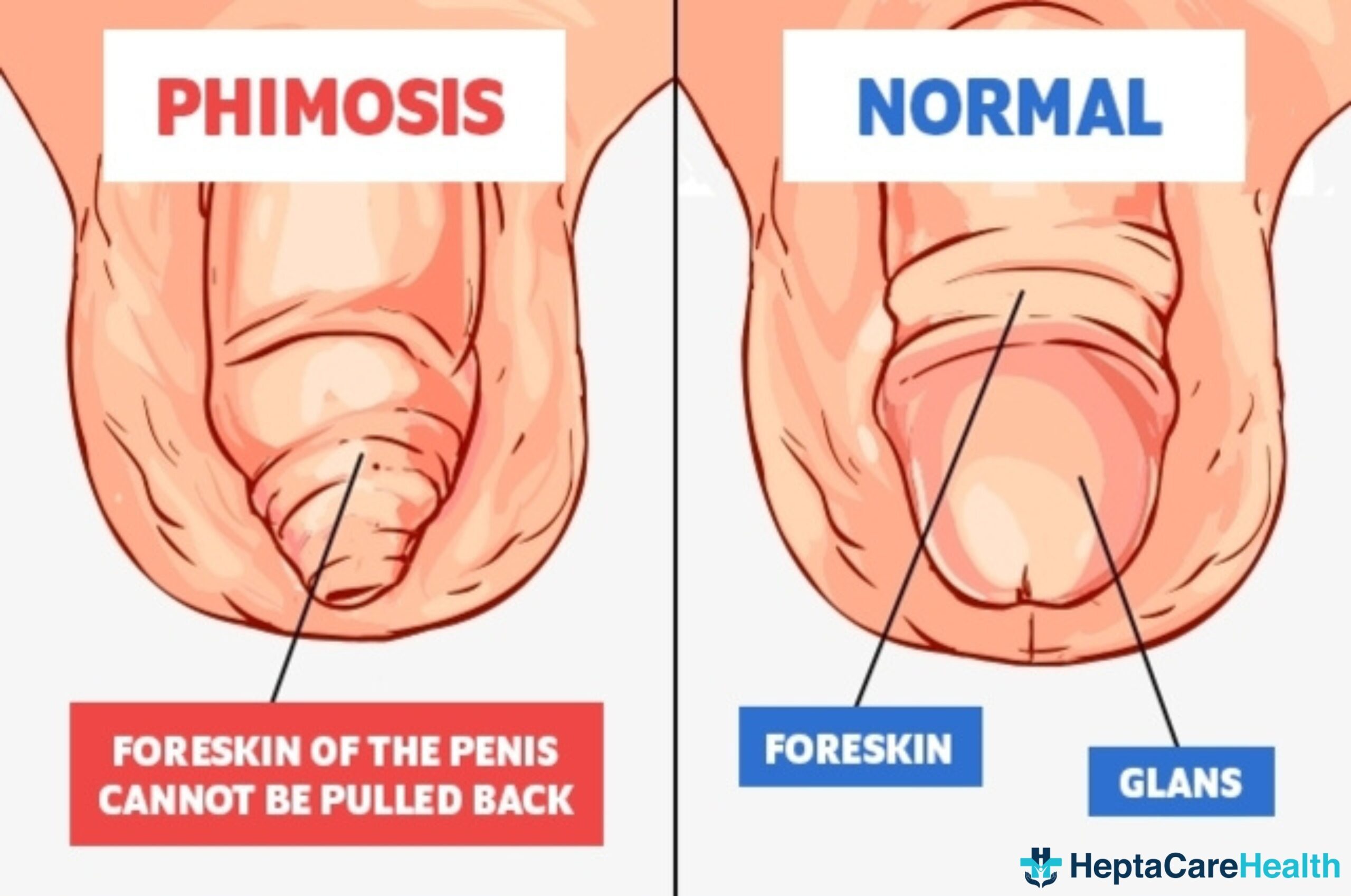Phimosis is characterized by the inability to retract the foreskin over the head of the penis. While mild to moderate phimosis may be managed through medications and ointments, severe cases usually require surgical procedures such as circumcision.
At HeptaCare Health, we provide advanced and minimally invasive laser circumcision procedures to treat phimosis. Contact us at HeptaCare Health and consult our highly experienced and qualified phimosis specialists for the best phimosis treatment.
Happy Patients
Disease
Hospitals
Cities
Phimosis is a penile condition in which the foreskin, a retractable fold of skin at the top of the penis, cannot be pulled back or retracted over the head, or the glans, of the penis.
Phimosis itself is usually not a problem. As long as it does not cause you any pain or discomfort or affect your daily life, it does not require any surgical intervention. However, severe cases of phimosis may require surgical procedures such as circumcision or foreskin removal.
Phimosis usually occurs naturally and is found in almost all newborn babies and young boys. With time, however, the foreskin starts to loosen up on its own and resolves itself before adolescence. But in some cases, it can last into adulthood as well.
While non-surgical options such as steroid creams may give you temporary relief from its phimosis symptoms, surgery is generally considered to be an effective and safe solution to phimosis in adults.

There are primarily two types of phimosis: Physiological phimosis and pathological phimosis.
Prior to phimosis surgery, your healthcare provider will likely perform some simple tests and diagnostics to not only assess your overall health but also uncover any underlying medical conditions you may have that could require additional care and precautions either during or after surgery.
In case of phimosis, diagnosis generally begins with a simple, routine physical examination. Your urologist will try to gently retract the skin that covers the penile glans manually. If the foreskin is not retractable or the penile glans are not completely visible, it indicates phimosis.
Alongside, your urologist will likely ask you about your medical and surgical history, the symptoms you’re facing, any injury that may have occurred on your penis or questions regarding your sexual activity to further understand your condition. Your urologist may also examine the penis to check for signs of any infection or injuries.
Depending on the severity of your condition, your urologist may try some non-surgical approaches such as steroid creams and ointments but if they fail to have any significant effect, a surgery may be the only solution.
Circumcision is a urological procedure that is generally performed as a safe and effective treatment for various foreskin related conditions including phimosis.
In a circumcision procedure, the foreskin is cut and removed from the penis. There are primarily 3 methods of performing a circumcision surgery:
Laser circumcision or laser phimosis treatment is one of the most advanced and minimally invasive surgical procedures that are commonly performed and recommended by most urologists for patients seeking to undergo circumcision surgery.
In a laser circumcision, the urologist uses a highly focused beam of laser to precisely cut and remove any excess foreskin from your penis without the risk of any deep cuts.
Due to its high operating temperature, the incision wound is also cauterized, minimizing chances of any excessive bleeding as well.
Compared to laser circumcision, stapler circumcision is generally considered to be a more conventional form of performing circumcision in which the surgeon uses a stapler device, an advanced and disposable surgical tool that is specially designed to perform circumcisions, to cut and remove the foreskin.
In a stapler circumcision, the surgeon places the stapler device over the head of the penis and removes the foreskin in a quick motion. Once the foreskin is removed, the stapler device leaves behind a silicone ring around the incision wound to close it off and minimize bleeding.
The silicone ring falls off on its own once the incision wound has healed completely, which generally takes 7-10 days.
Open circumcision, often referred to as the dorsal slit technique, is a conventional method of performing circumcision in which the surgeon makes an incision along the upper length of the foreskin from the tip of the corona to expose the penile glans using a scalpel or surgical scissors.
Compared to laser or stapler circumcision, open circumcision is more invasive in nature and requires more recovery time. Due to its invasive nature, it also carries a significant risk of complications and infection as well.
In most cases, recovery after a circumcision surgery can take anywhere from 7-10 days. Depending on various factors, however, such as the method of surgery you choose, your overall health and quality of postoperative care, the exact time to recover after your surgery is likely to vary. In this period , it is important to strictly follow any guidelines or precautions set by your urologist to not only minimize chances of any postoperative complications but also boost recovery. Some guidelines or precautions that your urologist may suggest you after your circumcision surgery include:
The average phimosis surgery cost in India can range anywhere from Rs. to Rs. . Depending on various factors, however, such as the method of your surgery, the cost of preoperative tests and diagnostics and the cost of postoperative medications, the exact cost of your surgery is likely to vary. Circumcision surgery is generally covered by most health insurance plans in India if it is deemed to be a medical necessity by your healthcare provider.If left untreated, Phimosis can lead to a multitude of penis-related complications and diseases that not only affect your everyday life but also may require additional, more complex surgical procedures for treatment.2However, if the reason behind your circumcision is strictly cosmetic or religious in nature, it is highly unlikely that your insurance plan will provide coverage for it.Prior to surgery, it is best to have a detailed discussion about your insurance plan and its inclusions and exclusions with your insurance provider. If you still have any queries, you can also get in touch with our insurance team at HeptaCare Health for further assistance.
Alongside its capability to effectively treat phimosis, circumcision also has various additional benefits. Some of the benefits that are commonly associated with circumcision surgery include:
Generally, circumcision surgery does not require any special preparations. Following some simple steps that may be recommended to you by your urologist will likely be enough. However, in case your doctor advises you any special precautions, make sure to follow them strictly. Some preoperative preparations that your urologist may advise you to make include:
Before going forward with a surgery, your healthcare provider may recommend some non-surgical alternatives to circumcision that may help you reduce symptoms of phimosis and provide effective phimosis treatment without surgery
Certain infections and skin conditions can also cause phimosis and in such cases, your urologist may prescribe you some medications for treatment. It is to be noted that before taking any phimosis medication, it is extremely important to consult your urologist first. Some phimosis medication that your urologist may prescribe are given below:
Some methods of phimosis home treatment that you can perform for effective phimosis management include:
Laser circumcision is generally considered to be the most safe and effective treatment for phimosis. Phimosis laser surgery uses a highly focused beam of laser to precisely cut and remove any excess foreskin that you may have.Due to its precise nature and high operating temperatures, laser circumcision does not involve the risk of any deep cuts or excessive bleeding.Phimosis laser surgery is also recommended by most urologists due to its shorter recovery and better postoperative quality of life as compared to conventional methods of circumcision, such as a stapler or open circumcision.
This is a common condition that is found in almost all newborn babies. As a person continues to age, the foreskin continues to loosen up and does not require any surgical intervention.In some cases, however, phimosis can last into adulthood and, depending on its severity, may require surgical procedures such as circumcision for effective phimosis cure.in adulthood can be a significant problem that affects your daily life and health. If left untreated, phimosis can lead to serious complications as well that may require additional and more complex surgical procedures for treatment. If you are experiencing symptoms of phimosis, it is advisable to contact your healthcare provider and undergo effective phimosis treatment in adulthood.
After your circumcision surgery, some common side effects, such as mild swelling, minor bleeding and discomfort, are to be expected and are considered normal.These side effects generally do not require any medications or additional care and are expected to subside on their own in a few days. However, if these side effects seem to persist or worsen over time, it could be a sign of a complication. It is recommended to inform your healthcare provider about the symptoms you may be facing as soon as possible.Some of the most common complications that are usually associated with phimosis surgery are given below:

There are several steroid-based as well as non-steroid based ointments available for the treatment . These ointments help by loosening the foreskin and their success rate is around 70%.
Let’s look at some of the most widely used ointments for the treatment of phimosis:
1. Betnovate-N
It is the most common ointment used for treating phimosis. Betnovate-N is an ointment that contains a steroid named betamethasone valerate. In addition to this steroid, it has an antibacterial agent (neomycin sulphate), a preservative and a base.
Betnovate majorly helps in getting relief from eczema, psoriasis and lichen planus which are some of the common causes of phimosis. To get a sigh of relief from the redness, swelling and irritation caused due to phimosis,
You should apply the ointment twice or thrice a day for about 4-6 weeks to get. Doing so will bring you significant relief from redness, swelling, and irritation. Also, remember the ointment is not advisable for children under the age of 1 year. So, consult a doctor first, if your child is suffering from phimosis.
Temovate is yet another topical steroid prescribed for the treatment of phimosis. It contains clobetasol propionate(0.05%) as an active ingredient.
Temovate is available both in the form of cream as well as ointments. Temovate acts against skin conditions like eczema, psoriasis, etc and thus helps in reducing the swelling, itching, and redness. You should use Temovate twice a day for about 2 weeks. The usage of Temovate should not be continued for more than 2 weeks. Prolonged use of Temovate can have side-effects.
Canesten is an anti-fungal cream that mainly contains Clotrimazole. Clotrimazole is a medicine that is used to treat fungal infections.
Thus, Canesten is prescribed for phimosis when the cause of phimosis is a fungal infection. Clotrimazole present in Canesten helps in reducing the inflammation and soreness caused due to phimosis.
Elocon ointment contains a mild steroid named Mometasone furoate(0.1%). It has an anti-inflammatory effect on phimosis. Elocon is very effective in the treatment of eczema, lichen planus, psoriasis, etc. In addition to ointment form, Elocon is also available in the form of cream and lotion.
The type of product to use for phimosis depends upon the condition of the skin. This ointment helps in getting relief from swelling, redness, and itching in about 2 weeks. Elocon should not be used for children under the age of 2 years.
Novoglan is an organic cream that helps in stretching the foreskin. It contains natural ingredients with anti-inflammatory and anti-oxidant properties.
The major ingredients of Novoglan are neem seed oil, emu oil, evening primrose oil, rose geranium, jojoba oil, rice bran oil, wheat germ oil and Vitamin E.
You can apply Novoglan cream daily before stretching exercises. It conditions the foreskin and makes it easier to stretch. Thus, it is a very effective cream for phimosis that you can rely upon.
Aristospan is another topical steroid prescribed for phimosis. It contains Triamcinolone acetonide as the main active ingredient.
Triamcinolone acetonide has anti-inflammatory properties and helps in reducing the pain and soreness. This helps in loosening the skin and gentle stretching along with the use of Aristospan is really beneficial in the complete retraction of the skin.
Hydrocortisone is a corticosteroid effective in the treatment of phimosis. It is available in a variety of products including lotions, creams, ointments, and gels.
Hydrocortisone is effective against eczema and psoriasis and helps reduce inflammation, itching in phimosis. Hydrocortisone products are mostly mild and sometimes contain anti-microbial medicines that treat bacterial and fungal infections.
Ilotycin is a cream that contains erythromycin as the main component. Erythromycin is an antibiotic that is effective against bacterial infections. Ilotycin can be used for treating phimosis caused due to harmful bacterial growth.


Based on 7721 Recommendations | Rated 4.68 Out of 5
Happy Patients
Clinics
Cities
Surgeries
Doctors
Hospitals

Painless laser circumcision at Heptacare Health with quick recovery and expert care.

Safe stapler circumcision at Heptacare Health, offering precise, minimally invasive treatment with faster recovery.

Effective phimosis treatment at HeptaCare Health with expert care for safe and long-lasting results.

Expert balanoposthitis treatment at HeptaCare Health for safe, effective, and quick recovery care.

Safe hydrocele treatment at Heptacare Health with expert care and minimally invasive procedures for faster recovery.

Yes, circumcision is safe for newborns, children, and adults, but the method and anesthesia vary according to age.
Minor risks include swelling, mild pain, bleeding, or infection, which are rare and manageable with proper care.
No. Circumcision does not affect sexual performance or sensation significantly. Many patients report improved hygiene and reduced infections.
While circumcision can be elective, it is recommended for medical conditions like phimosis, recurrent infections, or hygiene issues.
● piles laser surgery cost in Vizag ● low-cost piles surgery in Hyderabad ● cashless piles treatment near me ● painless piles surgery in Vijayawada ● piles treatment with insurance in Vizag ● piles removal surgery cost in Hyderabad ● piles operation packages in Vijayawada ● affordable piles treatment near me ● piles laser treatment clinic in Hyderabad ● piles doctor consultation charges in Vizag ● best piles surgery cost in Vijayawada ● piles treatment hospital near me ● piles laser operation price in Hyderabad ● low-cost piles laser treatment in Vizag ● piles removal cost near me ● piles treatment with EMI in Vijayawada ● piles surgery specialist near me ● piles surgery packages in Hyderabad ● piles treatment clinic near me ● stapler circumcision treatment near me ● stapler circumcision surgery cost in Vizag ● painless stapler circumcision in Hyderabad ● stapler circumcision for adults near me ● best stapler circumcision clinic in Vijayawada ● stapler circumcision procedure cost in Hyderabad ● stapler circumcision surgery packages near me ● stapler circumcision treatment hospital in Vizag ● affordable stapler circumcision surgery near me ● stapler circumcision consultation charges in Hyderabad ● stapler circumcision surgery with EMI option ● advanced stapler circumcision surgery near me
Disclaimer: **The result and experience may vary from patient to patient.. ***By submitting the form or calling, you agree to receive important updates and marketing communications.
Getting an accurate diagnosis can be one of the most impactful experiences that you can have.

cure with care
Copyright © 2025. All rights reserved.
Consult with our expert surgeon for more than 50+ diseases
Happy Patients
Hospitals
Cities